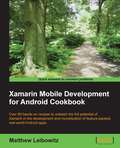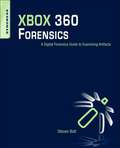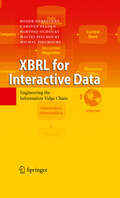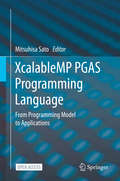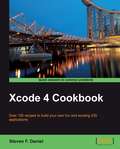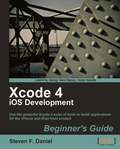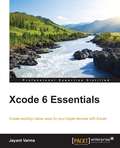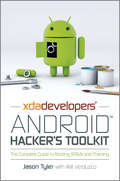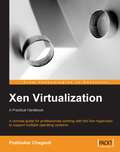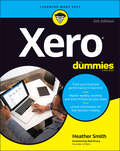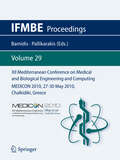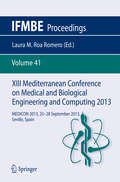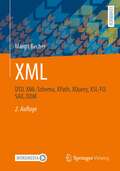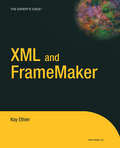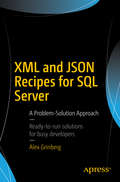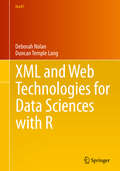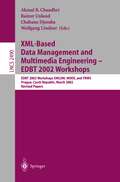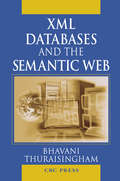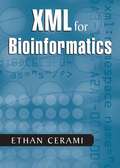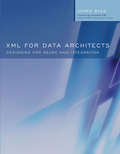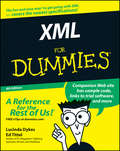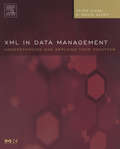- Table View
- List View
Xamarin Mobile Development for Android Cookbook
by Matthew LeibowitzOver 80 hands-on recipes to unleash full potential for Xamarin in development and monetization of feature-packed, real-world Android apps About This Book • Create a number of Android applications using the Xamarin Android platform • Extensively integrate your Android devices with other Android devices to enhance your app creation experience • A comprehensive guide packed with real-world scenarios and pro-level practices and techniques to help you build successful Android apps Who This Book Is For If you are a Xamarin developer who wants to create complete Android applications with Xamarin, then this book is ideal for you. No prior knowledge of Android development is needed, however a basic knowledge of C# and .NET would be useful. What You Will Learn • Install and use Xamarin.Android with Xamarin Studio and Visual Studio • Design an app's user interface for multiple device configurations • Store and protect data in databases, files, and on the cloud • Utilize lists and collections to present data to the user • Communicate across the network using NFC or Bluetooth • Perform tasks in the background and update the user with notifications • Capture and play multimedia, such as video and audio, with the camera • Implement In-App Billing and Expansion Files and deploy to the store In Detail Xamarin is used by developers to write native iOS, Android, and Windows apps with native user interfaces and share code across multiple platforms not just on mobile devices, but on Windows, Mac OS X, and Linux. Developing apps with Xamarin.Android allows you to use and re-use your code and your skills on different platforms, making you more productive in any development. Although it's not a write-once-run-anywhere framework, Xamarin provides native platform integration and optimizations. There is no middleware; Xamarin.Android talks directly to the system, taking your C# and F# code directly to the low levels. This book will provide you with the necessary knowledge and skills to be part of the mobile development era using C#. Covering a wide range of recipes such as creating a simple application and using device features effectively, it will be your companion to the complete application development cycle. Starting with installing the necessary tools, you will be guided on everything you need to develop an application ready to be deployed. You will learn the best practices for interacting with the device hardware, such as GPS, NFC, and Bluetooth. Furthermore, you will be able to manage multimedia resources such as photos and videos captured with the device camera, and so much more! By the end of this book, you will be able to create Android apps as a result of learning and implementing pro-level practices, techniques, and solutions. This book will ascertain a seamless and successful app building experience. Style and approach This book employs a step-by-step approach to Android app creation, explained in a conversational and easy-to-follow style. A wide range of examples are listed to ensure a complete understanding of how to deploy competent apps on the Android market.
XBOX 360 Forensics: A Digital Forensics Guide to Examining Artifacts
by Steven BoltXBOX 360 Forensics is a complete investigation guide for the XBOX game console. Because the XBOX 360 is no longer just a video game console — it streams movies, connects with social networking sites and chatrooms, transfer files, and more — it just may contain evidence to assist in your next criminal investigation. The digital forensics community has already begun to receive game consoles for examination, but there is currently no map for you to follow as there may be with other digital media. XBOX 360 Forensics provides that map and presents the information in an easy-to-read, easy-to-reference format. This book is organized into 11 chapters that cover topics such as Xbox 360 hardware; XBOX LIVE; configuration of the console; initial forensic acquisition and examination; specific file types for Xbox 360; Xbox 360 hard drive; post-system update drive artifacts; and XBOX Live redemption code and Facebook. This book will appeal to computer forensic and incident response professionals, including those in federal government, commercial/private sector contractors, and consultants.Game consoles are routinely seized and contain evidence of criminal activity Author Steve Bolt wrote the first whitepaper on XBOX investigations
XBRL for Interactive Data: Engineering the Information Value Chain
by Roger Debreceny Carsten Felden Bartosz Ochocki Maciej Piechocki Michal PiechockiInteractive data supports organizations to communicate effectively with their stakeholders and partners on the Internet and the World Wide Web. XBRL (eXtensible Business Reporting Language) is a key enabling technology for interactive data. XBRL links organizations and knowledge consumers in a variety of information value chains. XBRL is now in use in many countries and important settings. This book provides, for the first time, an in-depth analysis of XBRL. Thorough and up-to-date, this book explains the most popular constructs in XML, on which XBRL builds, and XBRL. The book provides business and policy makers, technologists and information engineers with an essential toolkit to understand the complete implementation of XBRL. The book begins with an overview of the business case for interactive data and XBRL. There is an introduction to XML and XBRL and the design and construction of XBRL taxonomies including extensions and multi-dimensional XBRL implementations. It provides a detailed analysis of the interaction of instance documents and taxonomies. The book also provides a synopsis of the most current XBRL technologies.
XcalableMP PGAS Programming Language: From Programming Model to Applications
by Mitsuhisa SatoXcalableMP is a directive-based parallel programming language based on Fortran and C, supporting a Partitioned Global Address Space (PGAS) model for distributed memory parallel systems. This open access book presents XcalableMP language from its programming model and basic concept to the experience and performance of applications described in XcalableMP. XcalableMP was taken as a parallel programming language project in the FLAGSHIP 2020 project, which was to develop the Japanese flagship supercomputer, Fugaku, for improving the productivity of parallel programing. XcalableMP is now available on Fugaku and its performance is enhanced by the Fugaku interconnect, Tofu-D. The global-view programming model of XcalableMP, inherited from High-Performance Fortran (HPF), provides an easy and useful solution to parallelize data-parallel programs with directives for distributed global array and work distribution and shadow communication. The local-view programming adopts coarray notation from Coarray Fortran (CAF) to describe explicit communication in a PGAS model. The language specification was designed and proposed by the XcalableMP Specification Working Group organized in the PC Consortium, Japan. The Omni XcalableMP compiler is a production-level reference implementation of XcalableMP compiler for C and Fortran 2008, developed by RIKEN CCS and the University of Tsukuba. The performance of the XcalableMP program was used in the Fugaku as well as the K computer. A performance study showed that XcalableMP enables a scalable performance comparable to the message passing interface (MPI) version with a clean and easy-to-understand programming style requiring little effort.
Xcode 4 Cookbook
by Steven F. DanielThis is a Cookbook with easy-to-follow recipes containing practical and detailed examples which are all fully backed up with code, illustrations, and tips. If you ever wanted to build applications that integrate Facebook, iCloud, Core Location, and the Core Motion frameworks into your own applications then this book is for you. You should have a good knowledge and programming experience with Objective-C and have used Xcode 4 and iOS 5.
Xcode 4 iOS Development Beginner's Guide
by Steven F. DanielThis step-by-step book guides you through the process of creating awesome iPhone apps using Xcode 4. As a beginner's guide, it focuses on getting you through all the major learning points in a smooth, logical order while showing you how to avoid some common pitfalls. If you want to learn how to build iPhone applications that compete with the rest and make your mark within the iPhone industry, this book is for you. You should have some basic programming experience with Objective-C, and a good understanding of OOP, as well as some knowledge of database design. No knowledge of Xcode 4 is required.
Xcode 6 Essentials
by Jayant VarmaThis book is aimed at developers who want to make applications for Apple devices with Xcode. iOS developers who have experience using other frameworks and languages can now migrate to Xcode and build creative, native apps.
XDA Developers' Android Hacker's Toolkit: The Complete Guide to Rooting, ROMs and Theming
by Jason TylerMake your Android device truly your own Are you eager to make your Android device your own but you're not sure where to start? Then this is the book for you. XDA is the world's most popular resource for Android hacking enthusiasts, and a huge community has grown around customizing Android devices with XDA. XDA's Android Hacker's Toolkit gives you the tools you need to customize your devices by hacking or rooting the android operating system. Providing a solid understanding of the internal workings of the Android operating system, this book walks you through the terminology and functions of the android operating system from the major nodes of the file system to basic OS operations. As you learn the fundamentals of Android hacking that can be used regardless of any new releases, you'll discover exciting ways to take complete control over your device. Teaches theory, preparation and practice, and understanding of the OS Explains the distinction between ROMing and theming Provides step-by-step instructions for Droid, Xoom, Galaxy Tab, LG Optimus, and more Identifies the right tools for various jobs Contains new models enabling you to root and customize your phone Offers incomparable information that has been tried and tested by the amazing XDA community of hackers, gadgeteers, and technicians XDA's Android Hacker's Toolkit is a simple, one-stop resource on hacking techniques for beginners.
XDA Developers' Android Hacker's Toolkit: The Complete Guide to Rooting, ROMs and Theming
by Jason TylerMake your Android device truly your own Are you eager to make your Android device your own but you're not sure where to start? Then this is the book for you. XDA is the world's most popular resource for Android hacking enthusiasts, and a huge community has grown around customizing Android devices with XDA. XDA's Android Hacker's Toolkit gives you the tools you need to customize your devices by hacking or rooting the android operating system. Providing a solid understanding of the internal workings of the Android operating system, this book walks you through the terminology and functions of the android operating system from the major nodes of the file system to basic OS operations. As you learn the fundamentals of Android hacking that can be used regardless of any new releases, you'll discover exciting ways to take complete control over your device. Teaches theory, preparation and practice, and understanding of the OS Explains the distinction between ROMing and theming Provides step-by-step instructions for Droid, Xoom, Galaxy Tab, LG Optimus, and more Identifies the right tools for various jobs Contains new models enabling you to root and customize your phone Offers incomparable information that has been tried and tested by the amazing XDA community of hackers, gadgeteers, and technicians XDA's Android Hacker's Toolkit is a simple, one-stop resource on hacking techniques for beginners.
Xen Virtualization: A Fast And Practical Guide To Supporting Multiple Operating Systems With The Xen Hypervisor
by Prabhakar ChagantiEach chapter is a collection of practical tasks that demonstrate how to achieve common virtualization tasks ou then learn how it works so that you can apply this knowledge to your Xen installation and environment. This book is for Linux administrators who want to use Xen virtualization for development, testing, virtual hosting, or operating systems training.
Xero For Dummies
by Heather SmithYour comprehensive guide to using Xero Keeping your business running smoothly has never been easier with Xero. You’re in good hands with Xero For Dummies, the only book endorsed by Xero. With the tips and tricks included in this helpful guide, you can easily tackle tasks like accounts payable, invoices, and estimates. It’s packed with easy to follow explanations and instructions on how to use this popular accounting software. It’s like having a personal accountant at your fingertips! The latest update to this useful reference shows how you can use Xero for more than a simple spreadsheet. It includes how to set up your account from scratch, convert your business from another accounting software to Xero, and use Xero to its full potential. It includes these essential topics: Customize the Xero set-up for your business Manage your daily activities with contacts, accounts, sales, and payables Organize suppliers and customers Automate your weekly and monthly reporting routines Track inventory and monitor your business Sync seamlessly across other business platformsFilled with real-world scenarios that shows how you can use Xero every day in your business, Xero For Dummies can help you get your paperwork done quickly, so you can spend your valuable time running your business. Pick up your copy of Xero For Dummies to make that your reality.
Xero For Dummies
by Heather SmithYour comprehensive guide to using Xero Keeping your business running smoothly has never been easier with Xero. You’re in good hands with Xero For Dummies, the only book endorsed by Xero. With the tips and tricks included in this helpful guide, you can easily tackle tasks like accounts payable, invoices, and estimates. It’s packed with easy to follow explanations and instructions on how to use this popular accounting software. It’s like having a personal accountant at your fingertips! The latest update to this useful reference shows how you can use Xero for more than a simple spreadsheet. It includes how to set up your account from scratch, convert your business from another accounting software to Xero, and use Xero to its full potential. It includes these essential topics: Customize the Xero set-up for your business Manage your daily activities with contacts, accounts, sales, and payables Organize suppliers and customers Automate your weekly and monthly reporting routines Track inventory and monitor your business Sync seamlessly across other business platformsFilled with real-world scenarios that shows how you can use Xero every day in your business, Xero For Dummies can help you get your paperwork done quickly, so you can spend your valuable time running your business. Pick up your copy of Xero For Dummies to make that your reality.
XII Mediterranean Conference on Medical and Biological Engineering and Computing 2010: MEDICON 2010, 27-30 May 2010, Chalkidiki, Greece (IFMBE Proceedings #29)
by Nicolas Pallikarakis Panagiotis D. BamidisOver the past three decades, the exploding number of new technologies and applications introduced in medical practice, often powered by advances in biosignal processing and biomedical imaging, created an amazing account of new possibilities for diagnosis and therapy, but also raised major questions of appropriateness and safety. The accelerated development in this field, alongside with the promotion of electronic health care solutions, is often on the basis of an uncontrolled diffusion and use of medical technology. The emergence and use of medical devices is multiplied rapidly and today there exist more than one million different products available on the world market. Despite the fact that the rising cost of health care, partly resulting from the new emerging technological applications, forms the most serious and urgent problem for many governments today, another important concern is that of patient safety and user protection, issues that should never be compromised and expelled from the Biomedical Engineering research practice agenda.
XIII Mediterranean Conference on Medical and Biological Engineering and Computing 2013: MEDICON 2013, 25-28 September 2013, Seville, Spain (IFMBE Proceedings #41)
by Laura M. Roa RomeroThe general theme of MEDICON 2013 is "Research and Development of Technology for Sustainable Healthcare". This decade is being characterized by the appearance and use of emergent technologies under development. This situation has produced a tremendous impact on Medicine and Biology from which it is expected an unparalleled evolution in these disciplines towards novel concept and practices. The consequence will be a significant improvement in health care and well-fare, i.e. the shift from a reactive medicine to a preventive medicine. This shift implies that the citizen will play an important role in the healthcare delivery process, what requires a comprehensive and personalized assistance. In this context, society will meet emerging media, incorporated to all objects, capable of providing a seamless, adaptive, anticipatory, unobtrusive and pervasive assistance. The challenge will be to remove current barriers related to the lack of knowledge required to produce new opportunities for all the society, while new paradigms are created for this inclusive society to be socially and economically sustainable, and respectful with the environment. In this way, these proceedings focus on the convergence of biomedical engineering topics ranging from formalized theory through experimental science and technological development to practical clinical applications.
XML: DTD, XML-Schema, XPath, XQuery, XSL-FO, SAX, DOM
by Margit BecherDie Bedeutung von XML für eine Layout-unabhängige Beschreibung von Dokumenten und damit als Ausgangsformat für Single-Source-Publishing sowie als Austauschformat beim elektronischen Datenaustausch ist heute unstrittig. Anhand vieler Beispiele lernen Sie, wie mit den Sprachen DTD und XML-Schema eigene Auszeichnungssprachen definiert werden können. Ein weiterer Schwerpunkt dieses Buches bildet eine fundierte Einführung in Technologien zur Weiterverarbeitung von XML: XPath, XQuery und XSLT.
XML and FrameMaker
by Kay Ethier* This book appeals to a professional audience: Writers, database administrators, developers, and production staff, all of which have to capture or emit XML from existing documents or databases. * Describes the connection between XML and publishing; Explains how to use XML to create documents that may be published to many other formats. * Shows how to build an "XML round trip" for Adobe FrameMaker 7; Explains how FrameMaker’s powerful formatting features lend themselves to publishing of XML documents—without rework.
XML and JSON Recipes for SQL Server: A Problem-Solution Approach
by Alex GrinbergQuickly find solutions to dozens of common problems encountered while using XML and JSON features that are built into SQL Server. Content is presented in the popular problem-solution format. Look up the problem that you want to solve. Read the solution. Apply the solution directly in your own code. Problem solved!This book shows how to take advantage of XML and JSON to share data and automate tasks. JSON is commonly used to move data back and forth between the database and front-end applications, often running in a browser. This book shows all you need to know about transforming query results into JSON format, and back again. Also covered are the processes and techniques for moving data into and out of XML format for business intelligence and other purposes, such as when transferring data from a reporting system into a data warehouse, or between different database brands such as between SQL Server and Oracle.Microsoft intensively implements XML in SQL Server, and in many related products. Execution plans are generated in XML format, and this book shows you how to parse those plans and automate the detection of performance problems. The relatively new Extended Events feature writes tracing data into XML files, and the recipes in this book help in parsing those files. XML is also used in SQL Server's BI tool set, including in SSIS, SSR, and SSAS. XML is used in many configuration files, and is even behind the construction of DDL triggers. In reading this book you’ll dive deeply into the features that allow you to build and parse XML, and also JSON, which is a specific format of XML used to transmit objects in a web-friendly format between a database and its front-end applications.What You Will LearnBuild XML and JSON objects in support of automation and data transferImport and parse XML and JSON from operating system filesBuild appropriate indexes on XML objects to improve query performanceMove data from query result sets into JSON format, and back againAutomate the detection of database performance problems by querying and parsing the database’s own execution plansReplace external and manual JSON processes with SQL Server's internal, JSON functionalityWho This Book Is ForDatabase administrators, .NET developers, business intelligence developers, and other professionals who want a deep and detailed skill set around working with XML and JSON in a SQL Server database environment. Web developers will particularly find the book useful for its coverage of transforming database result sets into JSON text that can be transmitted to front-end web applications.
XML and Web Technologies for Data Sciences with R (Use R!)
by Deborah Nolan Duncan Temple LangWeb technologies are increasingly relevant to scientists working with data, for both accessing data and creating rich dynamic and interactive displays. The XML and JSON data formats are widely used in Web services, regular Web pages and JavaScript code, and visualization formats such as SVG and KML for Google Earth and Google Maps. In addition, scientists use HTTP and other network protocols to scrape data from Web pages, access REST and SOAP Web Services, and interact with NoSQL databases and text search applications. This book provides a practical hands-on introduction to these technologies, including high-level functions the authors have developed for data scientists. It describes strategies and approaches for extracting data from HTML, XML, and JSON formats and how to programmatically access data from the Web. Along with these general skills, the authors illustrate several applications that are relevant to data scientists, such as reading and writing spreadsheet documents both locally and via Google Docs, creating interactive and dynamic visualizations, displaying spatial-temporal displays with Google Earth, and generating code from descriptions of data structures to read and write data. These topics demonstrate the rich possibilities and opportunities to do new things with these modern technologies. The book contains many examples and case-studies that readers can use directly and adapt to their own work. The authors have focused on the integration of these technologies with the R statistical computing environment. However, the ideas and skills presented here are more general, and statisticians who use other computing environments will also find them relevant to their work.Deborah Nolan is Professor of Statistics at University of California, Berkeley.Duncan Temple Lang is Associate Professor of Statistics at University of California, Davis and has been a member of both the S and R development teams.
XML-Based Data Management and Multimedia Engineering - EDBT 2002 Workshops: EDBT 2002 Workshops XMLDM, MDDE, and YRWS, Prague, Czech Republic, March 24-28, 2002, Revised Papers (Lecture Notes in Computer Science #2490)
by Akmal B. Chaudhri Chabane Djeraba Rainer Unland Wolfgang LindnerThis volume comprises papers from the following three workshops that were part of the complete program for the International Conference on Extending Database Technology (EDBT) held in Prague, Czech Republic, in March 2002: XML-Based Data Management (XMLDM) Second International Workshop on Multimedia Data and Document Engineering (MDDE) Young Researchers Workshop (YRWS) Together, the three workshops featured 48 high-quality papers selected from approximately 130 submissions. It was, therefore, difficult to decide on the papers that were to be accepted for presentation. We believe that the accepted papers substantially contribute to their particular fields of research. The workshops were an excellent basis for intense and highly fruitful discussions. The quality and quantity of papers show that the areas of interest for the workshops are highly active. A large number of excellent researchers are working in relevant fields producing research output that is not only of interest to other researchers but also for industry. The organizers and participants of the workshops were highly satisfied with the output. The high quality of the presenters and workshop participants contributed to the success of each workshop. The amazing environment of Prague and the location of the EDBT conference also contributed to the overall success. Last, but not least, our sincere thanks to the conference organizers – the organizing team was always willing to help and if there were things that did not work, assistance was quickly available.
XML Databases and the Semantic Web
by Bhavani ThuraisinghamEfficient access to data, sharing data, extracting information from data, and making use of the information have become urgent needs for today's corporations. With so much data on the Web, managing it with conventional tools is becoming almost impossible. New tools and techniques are necessary to provide interoperability as well as warehousing betw
XML for Bioinformatics
by Ethan CeramiIntroduction The goal of this book is to introduce XML to a bioinformatics audience. It does so by introducing the fundamentals of XML, Document Type De?nitions (DTDs), XML Namespaces, XML Schema, and XML parsing, and illustrating these concepts with speci?c bioinformatics case studies. The book does not assume any previous knowledge of XML and is geared toward those who want a solid introduction to fundamental XML concepts. The book is divided into nine chapters: Chapter 1: Introduction to XML for Bioinformatics. This chapter provides an introduction to XML and describes the use of XML in biological data exchange. A bird’s-eye view of our ?rst case study, the Distributed Annotation System (DAS), is provided and we examine a sample DAS XML document. The chapter concludes with a discussion of the pros and cons of using XML in bioinformatic applications. Chapter 2: Fundamentals of XML and BSML. This chapter introduces the fundamental concepts of XML and the Bioinformatic Sequence Markup Language (BSML). We explore the origins of XML, de?ne basic rules for XML document structure, and introduce XML Na- spaces. We also explore several sample BSML documents and visualize these documents in the TM Rescentris Genomic Workspace Viewer.
XML for Data Architects: Designing for Reuse and Integration (The Morgan Kaufmann Series in Data Management Systems)
by James Bean"The book addresses a sorely missing set of considerations in the real world... This is a very timely book."-Peter Herzum, author of Business Component Factory and CEO of Herzum SoftwareXML is a tremendous enabler for platform agnostic data and metadata exchanges. However, there are no clear processes and techniques specifically focused on the engineering of XML structures to support reuse and integration simplicity, which are of particular importance in the age of application integration and Web services. This book describes the challenges of using XML in a manner that promotes simplification of integration, and a high degree of schema reuse. It also describes the syntactical capabilities of XML and XML Schemas, and the similarities (and in some cases limitations) of XML DTDs. This book presents combinations of architectural and design approaches to using XML as well as numerous syntactical and working examples.* Designed to be read three different ways: skim the margin notes for quick information, or use tables in the appendix to locate sections relevant the to a particular issue, or read cover-to-cover for the in-depth treatment. * Contains numerous tables that describe datatypes supported by the most common DBMSs and map to XML Schema supported data types.* Unique focus on the value added role and processes of the data architect as they apply to enterprise use of XML.
XML For Dummies
by Lucinda Dykes Ed TittelSee how XML works for business needs and RSS feeds Create consistency on the Web, or tag your data for different purposes Tag -- XML is it! XML tags let you share your format as well as your data, and this handy guide will show you how. You'll soon be using this markup language to create everything from Web sites to business forms, discovering schemas and DOCTYPES, wandering the Xpath, teaming up XML with Office 2003, and more. Discover how to * Make information portable * Use XML with Word 2003 * Store different types of data * Convert HTML documents to XHTML * Add CSS to XML * Understand and use DTDs
XML For Dummies
by Lucinda Dykes Ed TittelSee how XML works for business needs and RSS feeds Create consistency on the Web, or tag your data for different purposes Tag -- XML is it! XML tags let you share your format as well as your data, and this handy guide will show you how. You'll soon be using this markup language to create everything from Web sites to business forms, discovering schemas and DOCTYPES, wandering the Xpath, teaming up XML with Office 2003, and more. Discover how to * Make information portable * Use XML with Word 2003 * Store different types of data * Convert HTML documents to XHTML * Add CSS to XML * Understand and use DTDs
XML in Data Management: Understanding and Applying Them Together (The Morgan Kaufmann Series in Data Management Systems)
by Peter Aiken M. David AllenXML in Data Management is for IT managers and technical staff involved in the creation, administration, or maintenance of a data management infrastructure that includes XML. For most IT staff, XML is either just a buzzword that is ignored or a silver bullet to be used in every nook and cranny of their organization. The truth is in between the two. This book provides the guidance necessary for data managers to make measured decisions about XML within their organizations. Readers will understand the uses of XML, its component architecture, its strategic implications, and how these apply to data management.Takes a data-centric view of XMLExplains how, when, and why to apply XML to data management systemsCovers XML component architecture, data engineering, frameworks, metadata, legacy systems, and moreDiscusses the various strengths and weaknesses of XML technologies in the context of organizational data management and integration
